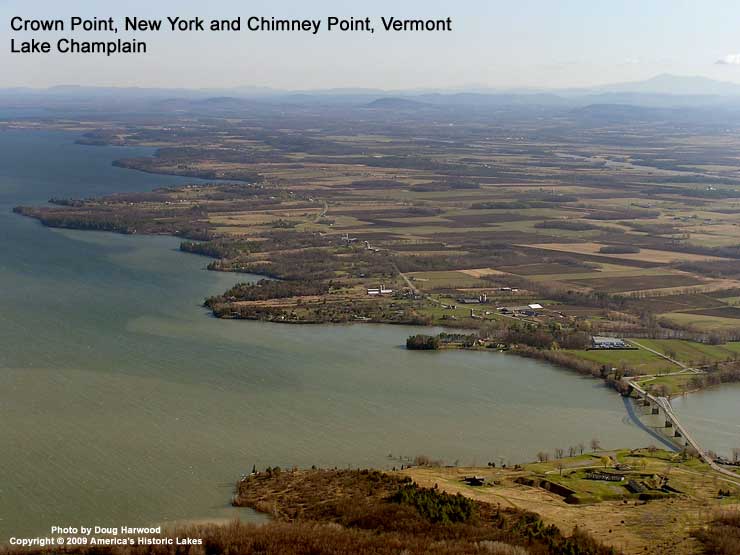|
|
|
|
We ask here, of course, questions that come to mind about our own fans. We hope so eagerly that the different organizations will develop community sites that we do not want to take their place !
We will however make an exception here.
On December 14, 2009, the "Place de l"Eventail" received an email (written in French, for which we thank the author, but with this English text too )I am an archeologist with the New York State Bureau of Historic Sites, which maintains, operates, and interprets 40 historic sites for the public. Recently we have been conducting research excavations at Crown Point, one of these historic sites. Crown Point ("Pointe à la Chevelure" for the French) is on Lake Champlain and was a contested location in the 18th century. The French occupied Crown Point in 1734, built a fort, and established settlements. In the Seven Years' War (1754-1763), British armies repeatedly attempted to attack and capture Crown Point, finally succeeding under Amherst in 1759. A new British fortress was constructed beginning in 1759, and a village developed outside the fortress. The American rebels took Crown Point in 1775. The village was destroyed when the American army abandoned Crown Point in October 1776.We have been excavating sites outside the British fortress that were within or near the English village of 1759-1776. In one deeply-buried soil layer representing an unknown period of occupation, we found many clay pipes, a few musket balls, and other artifacts including a very small piece of carved bone which we believe is part of the rib of a small fan. We do not know if this occupation layer is from a French village of ca. 1740 to 1759, or from the brief British soldiers' camp of 1759 just before the construction of the British fort beginning later in 1759. Construction fill from the 1759 fort covers over this early occupation layer.I am attaching an image of this piece of carved bone. It is very thin, about the thickness of a piece of pasteboard. Admittedly it is very small, but we know very little about fans and wonder if there is any chance you are able to identify it tentatively as to whether it is likely to be French or English. Any assistance will be very greatly appreciated.Paul R. HueyBureau of Historic SitesNew York State Office of Parks, Recreation and Historic Preservation
NB : informations about the Bureau of Historic Sites may be found at https://parks.ny.gov/historic-preservation/bhs/
A reconstruction at scale 1 of the object allowed me to check that it could be the top of the "gorge" of a fan stick fan with the characteristic part on which the rib is stuck on. |
(...)
1) Your fragment of bone seems to truly be a part of a fan stick. As it
narrows towards the axis, we may suppose that in spite of its small
width it was not a stick from a "monture squelette" but a part of a
"gorge" where sticks are not separated. Those considerations (if a ca
1800 may be taken for impossible due to the conditions of discovery)
lead me to suppose it was made before 1770, and may be 1st half of 18th
century 2) As it seems not to have been carved, pierced or even painted (?), we can presume it was a simple fan, may be a printed one. 3) To say more would be extremely uncertain, and mostly guessing. I would say that the chances it was English or from Northern Europe would be somewhat greater than French, but... 4) The main problems in my opinion are that - it will be very difficult to state exactly period and origin ; - even if it was possible this would not lead us to know something sure about the nationality of those people as - a fan is not part of the usual military paraphernalia ; - it may come from a gift (?), a "war trophy"... - the fragment is may be only some percent of the total fan. Why was this kept ? Where are the other parts ? (...) |
View of a stones French fort built in this locationi in 1736, replacing the original wooden one.
( Chaussegros de Léry (Gaspard-Joseph) Archives Nationales, FR CAOM 03DFC510A ) Paul Huey answered : (...) I understand the extreme difficulty in determining whether the fragment is French or English. Because of the great variety in fan designs, I was hoping an identifiable fan might have shouldered fan ribs identical in shape to this small fragment. But perhaps many simple fans have exactly this shape.This small fan fragment was found with other debris that was disposed from a dwelling. No other fan fragments were found, perhaps because we did not excavate the entire site. If this fan was English, it must predate 1775. If it was French, it most likely predates 1760. Of course, there is the slight chance that the English at Crown Point before 1775 had a post-1760 French fan. In summary, if an existing complete fan has ribs or sticks with the same shape, that is, with the same shape for a shoulder or narrowing from a wider section, I wonder if it might be possible to determine a possible date and nationality. You may publish or circulate the image if you wish. Thanks to this authorization... considering the historical interest of an eventual good answer and knowing that FANA, the Fan Circle, the Cercle de l'Eventail have also been asked (as well as C. Fendel), and after a last review by Mr Huey, we post now this question ! Please give us your piece of advice, which I will forward "as is" to Paul Huey, showing it on the website only if he asks so. |

I illustrate this question borrowing a viewue of the site, taken from http://www.historiclakes.org/crown_pt/furness.html (one of the websites with info about Crown Point)

...and do not forget the other questions